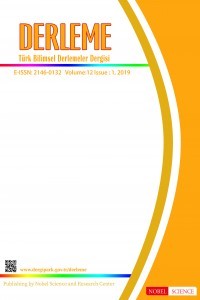Farklı Biyolojik Örnekler Geçirimli Elektron Mikroskop için nasıl hazırlanır?
geçirimli elektron mikroskobu
___
- KAYNAKLAR 1. Thompson RF, Walker M, Siebert CA, Muench SP, Ranson NA. An introduction to sample preparation and imaging by cryo-electron microscopy for structural biology. Methods, 2016; 100,, 3-15.
- 2. Park CH, Kim HW, Uhm CS. How to Get Well-Preserved Samples for Transmission Electron Microscopy, Applied Microscopy, 2016; 46 (4),188-192.
- 3. Frankl A, Mari M, Reggiori F. Electron microscopy for ultrastructural analysis and protein localization in Saccharomyces cerevisiae. Microb Cell 2015, 2(11), 412–428.
- 4. Wang H. Cryo-electron microscopy for structural biology: current status and future perspectives. Sci China Life Sci, 2015; 58(8), 750–756.
- 5. Taylor KA, Glaeser RM. Retrospective on the early development of cryoelectron microscopy of macromolecules and a prospective on the opportunities for the future. Journal of Structural Biology, 2008. 163(2008), 214–223.
- 6. Uhm CS, Park EK, Park CH. Tissue preparation with t-Butyl alcohol freeze-drying method for scanning electron microscopy: application for rat liver. Korean J Electron Microsc. 1998, 28, 299-306.
- 7. Hayat MA. Principles and Techniques of Electron Microscopy: Biological Applications. 1989 CRC Press, Boca Raton, FL.
- 8. Wisse E, Braet F, Duimel H, Vreuls C, Koek G, Steven WM, Damink O, Broek MAJ, Geest BD, Dejong CHC, Tateno C, Frederik P. Fixation methods for electron microscopy of human and other liver. World J Gastroenterol. 2010, 16 (23), 2851–2866.
- 9. Mascorro JA, Bozzola JJ. Processing Biological Tissues for Ultrastructural Study. In: Kuo J. (eds) Electron Microscopy Methods in Molecular Biology™, 2007, 369, 19-34 Humana Press
- 10. Bozola JJ, Russell LD. Electron Microscopy: Principles and Techniques forBiologists. second edition. 1992 John and Bartlett Publishers, Sudbury, Massachusetts, USA.
- 11. Taylor KA, Glaeser RM. Electron diffraction of frozen, hydrated protein crystals. Science 1974, 186(4168), 1036–37.
- 12. Adrian M, Dubochet J, Lepault J, McDowall AW. Cryo-electron microscopy of viruses. Nature 1984, 308, 32–36.
- 13. Costello MJ. Cryo-electron microscopy of biological samples.Ultrastruct Pathol. 2006, 30(5),361-71.
- 14. Studer D, Graber W, Al‐Amoudi A, Eggli PA. A new approach for cryofixation by high‐pressure freezing. J Microsc 2001, 203(3), 285–294
- 15. Carlemalm E, Garavito M, Villiger W. Resin development for electron microscopy and an analysis of embedding at low temperature. J Microsc, 1982, 126 (2), 123-143.
- 16. Tokuyasu KT. A technique for ultracryotomy of cell suspensions and tissues. J Cell Biol. 1973, 57(2), 551–565.
- 17. Mobius W. Cryopreparation of biological specimens for immunoelectron microscopyAnn. Anat-Anat. Anz., 2009, 191(3),231-247
- 18. Terracio L, Schwabe, KG. Freezing and drying of biological tissue for electron microscopy. J Histochem Cytochem. 1981, 29(9), 1021–8.
- 19. Giddings TH. Freeze-substitution protocols for improved visualization of membranes in high-pressure frozen samples. J. Microsc. 2003, 212(pt1), 53-61
- 20. Mcdonald KL. A review of high-pressure freezing preparation techniques for correlative light and electron microscopy of the same cells and tissues. Journal of microscopy 2009, 235(3), 273–281.
- 21. Ripper D, Schwarz H, Stierhof YD. Cryo-section immunolabelling of difficult to preserve specimens: advantages of cryofixation, freeze-substitution and rehydration. Biol. Cell 2008, 100(2), 109-123.
- 22. Cavalier A, Spehner D, Humbel BM. Handbook of Cryo-Preparation Methods for Electron Microscopy. (Eds.). 2009,CRC Press, Boca Raton, FL;
- 23. Edelmann L: Freeze-dried and resin-embedded biological material is well suited for ultrastructure research. J Microsc 2002, 207(1), 5–26
- 24. Al-Amoudi A1, Chang JJ, Leforestier A, McDowall A, Salamin LM, Norlén LP, Richter K, Blanc NS, Studer D, Dubochet J. Cryo-electron microscopy of vitreous sections. EMBO J. 2004, 23(18), 3583-8.
- Başlangıç: 2008
- Yayıncı: Nobel Bilim ve Araştırma Merkezi Limited
PESTİSİTLE KİRLENMİŞ ORTAMLARIN BİYOREMEDİASYONU
ŞULE AYBÜKE YAVUZ, ÜLKÜYE DUDU GÜL
Toprakta Ağır Metal Kirliliğinin İnsan Sağlığına Etkileri ve Çözüm Önerileri
Türkiye Organik Bitkisel Üretim Verileri ve Değerlendirilmesi
Nanoparçacıkların Ölçme ve İnceleme Teknikleri
Mobilya Endüstrisinde Kullanılan Makinelerde Çalışma Güvenliği
Hatice ULUSOY, Abdi ATILGAN, Hüseyin PEKER
Kalanchoe blossfeldiana Poelln. Türünde Yapılan Doku Kültürü Araştırmaları Üzerinde Bir İnceleme
Cevdet GÜMÜŞ, Ş.şebnem ELLİALTIOĞLU
Nematoda Dayanıklılık Sağlayan Genlerin Etkinliği Ve Sürekliliğinde Ürün Yönetim Stratejileri
Fatma Gül GÖZE ÖZDEMİR, Gülsüm UYSAL
Farklı Biyolojik Örnekler Geçirimli Elektron Mikroskop için nasıl hazırlanır?
